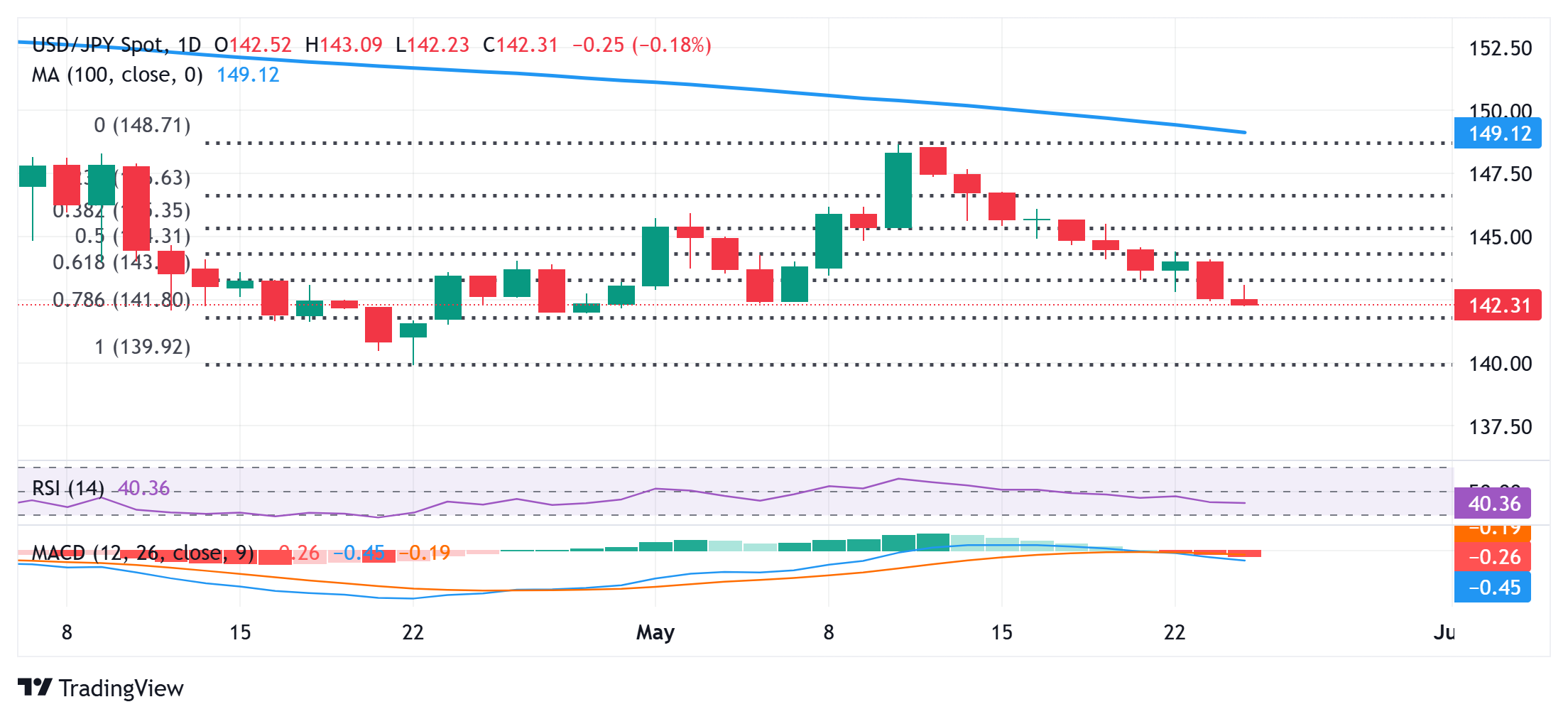Created
: 2025.05.26














![]() 2025.05.26 11:46
2025.05.26 11:46
The Japanese Yen (JPY) reverses a modest Asian session downtick against a broadly weaker US Dollar (USD) and touches a fresh monthly high during the Asian session on Monday. Japan's Prime Minister Shigeru Ishiba said on Sunday that he aims to achieve a trade agreement with the US during the Group of Seven (G7) summit on June 15. This comes on top of the growing acceptance that the Bank of Japan (BoJ) will continue raising interest rates and act as a tailwind for the JPY.
Apart from this, rising geopolitical risks stemming from the protracted Russia-Ukraine war and conflicts in the Middle East turn out to be another factor benefiting the JPY's relative safe-haven status against its American counterpart. Meanwhile, concerns about rising US fiscal deficit and expectations that the Federal Reserve (Fed) will eventually step in to support economic growth drag the USD to a near one-month low. This further contributes to the USD/JPY pair's slide.

From a technical perspective, an intraday failure near the 143.00 round-figure mark validates last week's breakdown below the 61.8% Fibonacci retracement level of April-May move higher. Adding to this, oscillators on the daily chart have been gaining negative traction and suggest that the path of least resistance for the USD/JPY pair remains to the downside. Some follow-through selling below the 142.00 mark will reaffirm the bearish outlook and drag spot prices below the 141.55 intermediate support, towards the 141.00 round figure. The subsequent downfall would expose the year-to-date low, or levels below the 140.00 psychological mark touched on April 22.
On the flip side, the Asian session peak, around the 143.10 area, now seems to act as an immediate hurdle, above which a bout of a short-covering move could lift the USD/JPY pair to the 143.65 region en route to the 144.00 round figure. The latter should act as a strong barrier, which, if cleared, could pave the way for a further recovery. However, the move higher might still be seen as a selling opportunity near the 144.80 zone and remain capped near the 145.00 psychological mark.
The Japanese Yen (JPY) is one of the world's most traded currencies. Its value is broadly determined by the performance of the Japanese economy, but more specifically by the Bank of Japan's policy, the differential between Japanese and US bond yields, or risk sentiment among traders, among other factors.
One of the Bank of Japan's mandates is currency control, so its moves are key for the Yen. The BoJ has directly intervened in currency markets sometimes, generally to lower the value of the Yen, although it refrains from doing it often due to political concerns of its main trading partners. The BoJ ultra-loose monetary policy between 2013 and 2024 caused the Yen to depreciate against its main currency peers due to an increasing policy divergence between the Bank of Japan and other main central banks. More recently, the gradually unwinding of this ultra-loose policy has given some support to the Yen.
Over the last decade, the BoJ's stance of sticking to ultra-loose monetary policy has led to a widening policy divergence with other central banks, particularly with the US Federal Reserve. This supported a widening of the differential between the 10-year US and Japanese bonds, which favored the US Dollar against the Japanese Yen. The BoJ decision in 2024 to gradually abandon the ultra-loose policy, coupled with interest-rate cuts in other major central banks, is narrowing this differential.
The Japanese Yen is often seen as a safe-haven investment. This means that in times of market stress, investors are more likely to put their money in the Japanese currency due to its supposed reliability and stability. Turbulent times are likely to strengthen the Yen's value against other currencies seen as more risky to invest in.
![]()
Created
: 2025.05.26
![]()
Last updated
: 2025.05.26

FXStreet is a forex information website, delivering market analysis and news articles 24/7.
It features a number of articles contributed by well-known analysts, in addition to the ones by its editorial team.
Founded in 2000 by Francesc Riverola, a Spanish economist, it has grown to become a world-renowned information website.
We hope you find this article useful. Any comments or suggestions will be greatly appreciated.
We are also looking for writers with extensive experience in forex and crypto to join us.
please contact us at [email protected].
Disclaimer:
All information and content provided on this website is provided for informational purposes only and is not intended to solicit any investment. Although all efforts are made in order to ensure that the information is correct, no guarantee is provided for the accuracy of any content on this website. Any decision made shall be the responsibility of the investor and Myforex does not take any responsibility whatsoever regarding the use of any information provided herein.
The content provided on this website belongs to Myforex and, where stated, the relevant licensors. All rights are reserved by Myforex and the relevant licensors, and no content of this website, whether in full or in part, shall be copied or displayed elsewhere without the explicit written permission of the relevant copyright holder. If you wish to use any part of the content provided on this website, please ensure that you contact Myforex.
Myforex uses cookies to improve the convenience and functionality of this website. This website may include cookies not only by us but also by third parties (advertisers, log analysts, etc.) for the purpose of tracking the activities of users. Cookie policy